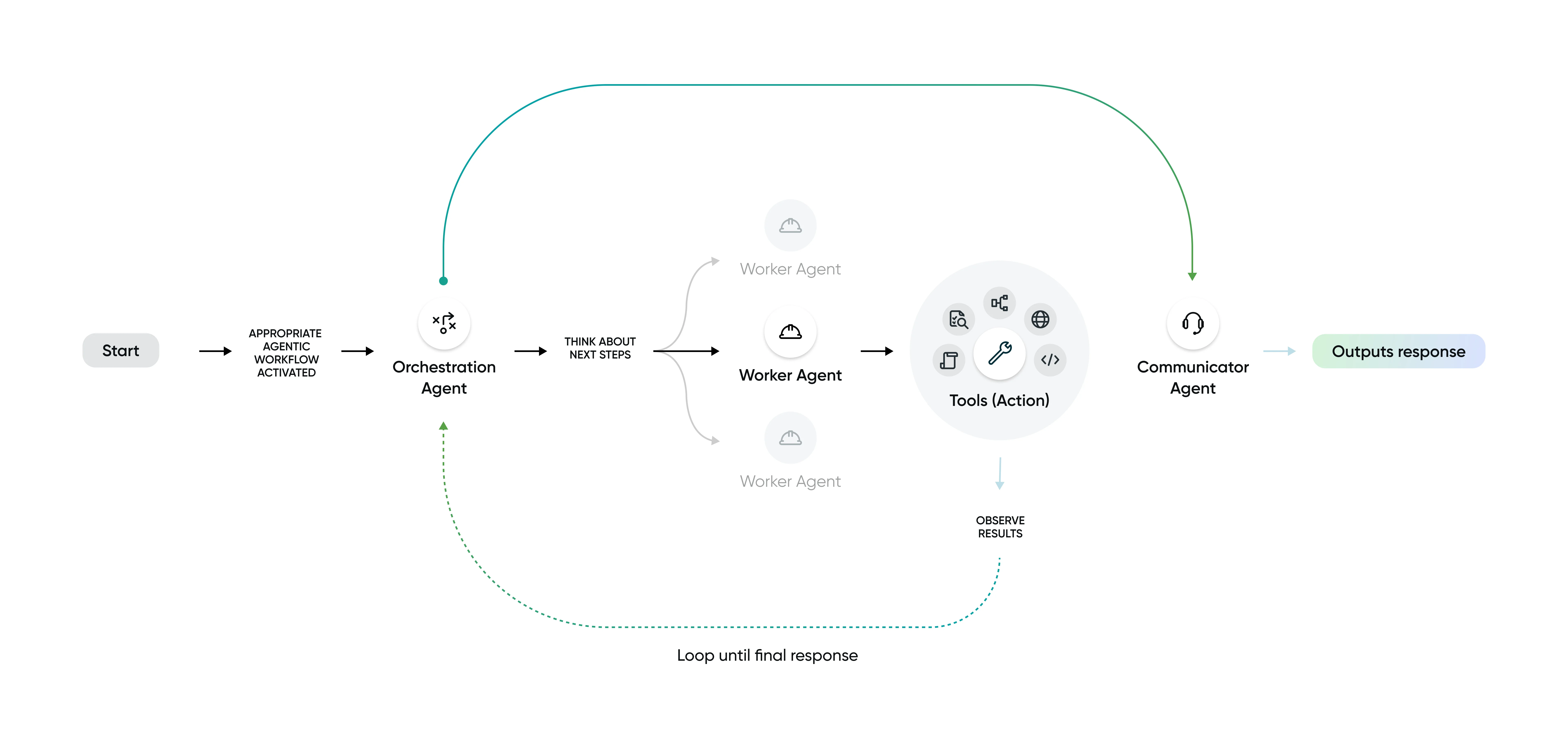What is agentic AI?
Agentic AI describes a system of AI agents that can interact with their environment to gather data, make decisions, and complete tasks independently or supervised by a human. Traditional and generative AI are powerful, but more reactive and scripted. Agentic AI has access to all of the same generative capabilities as the other types of AI, but can use these tools to dynamically take action on the users behalf. While humans are always in control, AI agents can be triggered by specific conditions and perform a series of steps on their own to reach a predefined goal.
Key characteristics
- Goal-driven action: It operates with a specific goal in mind, breaking down complex activities into manageable steps and acting independently to achieve them.
- Reasoning and planning: It can evaluate multiple options, anticipate outcomes, and work with other AI agents to make context-aware decisions.
- Tool usage: It can access and process information from multiple sources like knowledge articles, online sources, and APIs. It can also interact with software.
- Learning and adaptation: Through interactions and feedback, it refines understanding, improves decision-making, and increases effectiveness over time.

An agentic workflow starts when specific conditions are met, activating a group of AI agents who work together to complete the task.
View fullscreen
How does an agentic workflow start?
An agentic workflow is kicked off when certain predefined conditions are met. This start activates a group of AI agents who work together to complete the task.
AI agents perform tasks based on their roles
- The orchestration agent is the planner. Through reasoning and reflection, it figures out what needs to happen, breaks the goal into smaller tasks, and decides which agents should do what based on their roles. It also keeps checking if things are working—and adjusts the plan if needed.
- Worker agents take action. They each have tools they know how to use. When given a task, a worker agent chooses the right tool and does the job. Then it reports the outcomes back to the orchestration agent, which may adjust its plan, reassign tasks, or contact the human user.
- The communicator agent talks to humans. It explains what the system is doing and asks for input if needed. It also sends the user's responses back to the orchestration agent to help it plan the next steps.
It's a team effort until the job is complete
This process repeats—planning, doing, checking, and communicating—until the workflow goal is reached. If the AI gets stuck or needs help, it can ask the human for input before continuing.
AI agents in ServiceNow work like a smart team: they follow human direction, talk to each other, and adjust as they go. That’s what makes them powerful and helpful for building better experiences.
When to use AI agents
Agentic AI works best for complex, unpredictable scenarios where context matters, information is inconsistent, and users need adaptive guidance rather than rigid automation.
Common use cases
- Dynamic workflow optimization: AI analyzes, adjusts, and improves operations in real time. Examples include IT load balancing and supply chain adjustments.
- Self-improving systems: AI learns from past actions to optimize outcomes. Examples include refining marketing campaigns or adjusting pricing dynamically.
- IT incident management: AI detects system failures, suggests fixes, and executes recovery plans autonomously or with human oversight.
- Fraud detection & prevention: AI not only flags fraud but also blocks suspicious transactions automatically while escalating edge cases to humans.
- Personalized AI assistants: AI coordinates cross-team workflows, making decisions on behalf of users while keeping them informed.
When to avoid
For structured tasks, like those involving predictable automation, low complexity, or high-volume processes, agentic AI may not be the best approach. Traditional AI fits well with straightforward, more deterministic tasks. Here are a few use cases better suited for traditional AI:
- Data analysis and reporting: AI provides insights, like dashboards, anomaly detection, but doesn’t act.
- Recommendation systems: AI suggests options, like product recommendations or hiring matches, but a human decides.
- Pattern recognition: AI classifies emails as spam or detects fraudulent transactions but doesn’t intervene.
- Routine automation: AI automates repetitive, well-defined tasks like data entry or chatbot responses.
Key concepts
Understanding these concepts will help you as you build AI agents and agentic workflows in AI Agent Studio.
AI agents
Systems that can perceive their environment, collect data, and use that data to perform self-determined actions achieve predetermined goals defined by a human
Tools
Provide agents with the ability to complete a task or take action. Tools can include flows, flow actions, skills, scripts, and more
Agentic workflow
An outcome or goal achieved through a particular grouping of AI agents, each contributing specific capabilities to collectively fulfill the objective
Triggers
Conditions that kick off agentic activity without human intervention

